Erik Brown: Accounts from Thailand’s cave rescue Part 1
The rescue of the century took place June 23, 2018 in Thailand. The lives of twelve Thai boys and their coach were saved by a group of scuba divers, throwing diving into the global limelight, and captivating the world. One of the rescue divers sat down and told us about his part in the rescue…
Part 1 – Interview by Russell Clark

DIVER: How did you get into diving?
Erik: It was kind of a weird start. All of my friends are surfers, not divers, so I was actually living in Australia surfing everyday. Then I went to the Great Barrier Reef, did my Open Water course and got hooked. I stayed there for three months and went all the way to Divemaster. At the end of that trip I ended up dislocating my shoulder and having to come back to Canada for surgery. Surfing was no longer an option, so I tried to think of ways I could stay travelling and stay in the water, and that led me back into diving. I flew to the Philippines after my surgery and became an instructor. That was fifteen years ago and I never looked back.
How did you end up in Thailand?
After living in Egypt for seven or eight years, it was time to move on to something else. My friend owns a piece of land in Thailand and asked if I wanted to come over and build a little dive centre on it. I didn’t really have anything else going on, so there I was.
When did you first find out about the situation in the cave?
I was out on a wreck dive one day, came back in, and was having a few casual beers when one of the guys asked if I’d heard about the kids up in the cave. The first thing I did was hop on Google and do a bit of research. They were already in there four days when I found out, I was late to the party. I found out my friend Ben Reymenants was there and sent him a message.
What did he say?
Sometimes in these situations less is more. Too many hands can get in the way. I sent him a message and said me and another guy may fly up, if he still needed help. He said yes, so we flew up there the next morning.
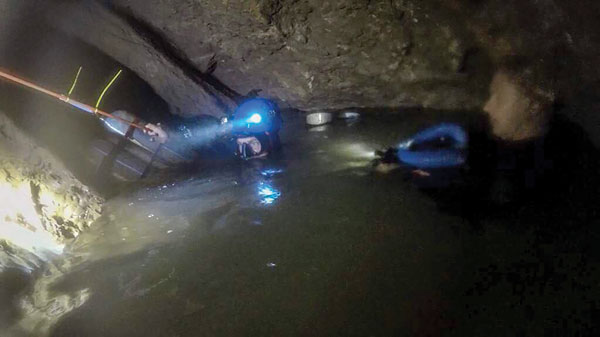
What made you feel confident about getting involved?
I’ve pretty much taught technical diving for the last ten years, but most of my diving was open ocean off the coast of Egypt on deeper wrecks. Cave diving is more of a passion, I don’t teach it, but I manage to spend a couple months a year on cave holidays in Mexico or Florida. Caves are where I find myself most relaxed. It is the diving I reserve for myself.
But when I went up there I didn’t have any anticipation of what I’d be doing, I literally thought that I’d be carrying tanks or doing whatever was needed. And if they did need us to go in, I’d be more comfortable with it being me than someone else.
You get off the plane, you arrive there, what the first thing that goes through your mind?
It was stressful. You have some of the best divers in the world there. When people with that level of experience are explaining the level of difficulty and hazards, it is intimidating. You have no clue what you’re getting yourself into. Some of the other recoveries or rescues I’ve been a part of, you know what you’re getting involved in, sort of. This was completely up in the air.
We went to the guest house where we were staying, and two hours later the guys got back from the cave that day. We got shown rough maps of the cave and some video footage of what we could expect to see the next day. If anything the conditions were worse. The video was useless as viz was zero and the audio alone sounded like a flowing river.
Things seemed to move quickly…
Everything happened so fast. The day I arrived was the day they found the kids. So I got there and six hours later they were found. All of a sudden everything was changing. It was like Fort Knox at the cave; we didn’t have our security passes yet. The other guys went to the entrance to see if it was true and what the plan was. We waited around the guest house for a few hours, by that point the video footage of the kids being found had been on TV, so you could see them. It really was a rollercoaster. Next morning we got up early and showed up to the cave site in our wetsuits thinking we’re going in, but everyone remained dry for the next three days as they worked out details. They did a very good job of not rushing in. Everything was very slow and calculated that way. We very quickly realized we didn’t need to be in our wetsuits and the planning process was going to take some time.
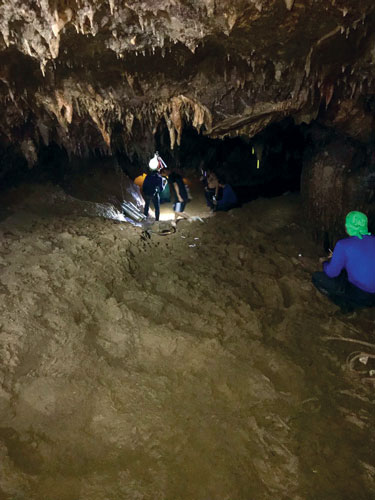
Tell us about the initial dives?
I found some of the dives fairly challenging to begin with, it’s not a dive you do for fun. But I was following a line – I couldn’t imagine the guys putting that line in. There were two different teams going back and fourth, and not only were they dealing with super heavy water flow – it’s literally them fighting against a river, it was flowing that fast – but the sediment from the first big rain fall brought the visibility down to zero. And they’re hauling in big thick cave line, not a neat and tidy cave reel. The logistics of what they had to do to get back to where the kids were was a Herculean effort.
By the time we got there they had a pulley system on the roof set up, we had help from the Marines, for the first few days, too. These guys were humping the tanks in on the their own and carrying 500m [1640 feet] of rope at a time. It’s quite impressive to see what they did.
How would you describe the cave?
It’s beautiful, to be fair. There was an artificial yellow light bathing everything and lighting the whole place up. Initially the entrance was a dive, but by the time we got there the water had gone down enough – I think it was one billion litres [264 million gallons] of water they pumped out of the cave over the whole span – we could actually walk into chamber three, which took about an hour. The first part of that was actually pretty calm, but sometimes you’d be up to your neck in water and have only a few inches of air space to breath. A lot of times it would open up into pretty big corridors. It was the last 200 metres [650 feet] where it was a 45 degree climb with crevices and mud, it was pretty treacherous.
I’m confident in caves. Being up there I learned a lot about the parellel world of sump diving. Call me crazy, but I personally like diving in conditions I can see. You train for zero viz and it happens, but never for a complete dive. Weather was obviously a really big issue for us, because the mountain was already so saturated; if it rained we felt those effects almost instantly inside the cave. It rained once and we got pulled out because they were afraid we’d get trapped in there by rising water.
I’m pretty interested to be going back in January when it’s dry. I’ll be able to get a better sense of it. There was so much equipment, mud, and people that I’m sure it will look like a completely different cave.
This was a real international effort of experts, right?
When I got there, there were my friends from Phukett – they’re Polish and Belgian. I went over with a Danish guy, my friend from Finland flew in, we had 50 US Marines, 20 Australian Federal Police, and you had the UK divers from the BCRC [British Cave Rescue Council]. It started with just Rick Stanton and John Volanthen who found the boys, but quickly five more divers from the UK joined. Of course you had the doctors, Richard Harris and Craig Callun, from Australia, and an engineering team from China. Apparently there were 2000 Thai military there and 900 police officers. There were a good 30-40 Thai Navy SEALs that were stationed inside the cave. Some spent six or seven days in there, working and operating and didn’t have the chance to come outside. There was no shortage of hands!
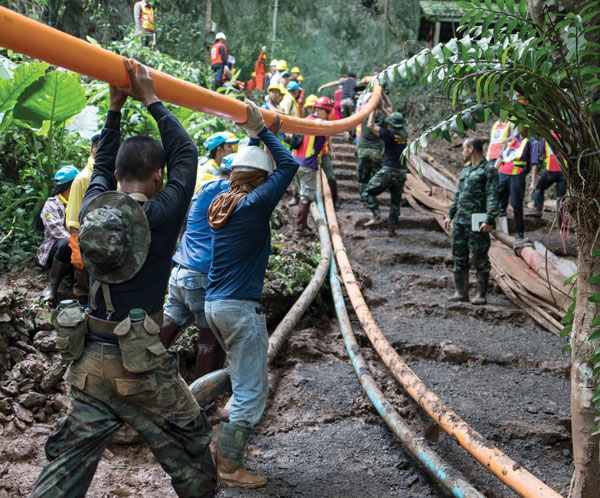
How was it working with the Thai Navy SEALs?
The whole operation was very military run. It was chaotic with that many people, but everyone did the best they could. When something needed to get done, it got done. Even in the planning, the level of communication and the hierarchy trickled down all the way to the dive operations. It was quite impressive. They have no shortage of work ethic. They’re machines, just constantly going, literally a row of them carrying tanks in and out.
Before the rescue started, how were the children being cared for?
When the divers initially found them, they had some minor food packets on them. But now the line had been laid all the way in, four Thai Navy SEALs went back there and spent the entire duration with the kids. Which is pretty incredible to think about because at that point in time, one of the ideas was to keep the kids in there for the four months. Swimming them out was far too dangerous. You have to remember these four Thai Navy SEALs who swam back in there (two of which where paramedics) volunteered, fully aware there was a chance they weren’t coming out for a couple months. That is hero shit.
As the other UK divers were flown in and assessed the scene, they would carry food packets back, so there were at least four or five missions before the rescue where people went back there with food rations. They had issues outside of that, every time we went back there we’d take a gas analyzer. The kids were going hypoxic; we got down to about 16% oxygen in the end. All these factors came into the timing and final call in the rescue decision. At one point they were trying to find ways to swim in a 4km [2.5 mile]-long low pressure hose to supply oxygen. The logistics of that are completly unrealitic. And with the rains only days away it was soon going to be impossible for divers to reach the kids. At this point there was a 3 or 4 day window to get them out before they ran out of options.
Who was making the actual dive decisions?
I wasn’t privy to a lot of the decision making conversations, it was military run with so many people. Our four man teams would pick one person to represent; they can’t have three hundred people in those meetings. I know the Thai’s had final say as to what happened, for the diving side they pretty much took what Rick [Stanton] and the guys said as gospel. They didn’t get questioned too much on it. Our support team was grouped under the US military; they were responsible for us, they took us under their wing, and most of the information for us got relayed through them.
Whenever you deal with water, especially a cave, it’s not usually a rescue, it’s a recovery. Nothing even comes remotely close to this. Everyone had to be realistic. To be honest, getting all thirteen kids out… there was high hopes but there was such an inherent risk in every single plan we had, we had to prepare that this may not go 100%.
Then news broke about the death of a Thai Navy SEAL…
As I mentioned, after the kids were found, we were dry for a couple days then as they started narrowing down a plan, we started prepping the cave so if we did need to go tomorrow we’re not wasting time. That was our job for the initial diving days, putting us in to make the line more efficient, make sure there’s no line traps to get entangled in. The water level had gone down in places so we had to untie the lines and bring them down under the waterline so we could navigate, and of course load the cave with tanks. Each time we’d go in, we’d take three tanks strapped between our legs and leave them in the cave system. In the four days we put in 60 tanks at different check points in the cave. It was the second day of this when we met a group of Navy Seals about to enter the water as we exited in chamber three. English was minimal so as we geared down and they geared up, you shook hands to wish everyone good luck. It wasn’t till the next morning that we got the horrible news of the accident. Diving stopped for the day. New procedures needed to be put in place. It was hard to swallow. The last thing you want in a rescue is something like this. The team rallied. I think they used it as motivation, to not let his death be in vain.
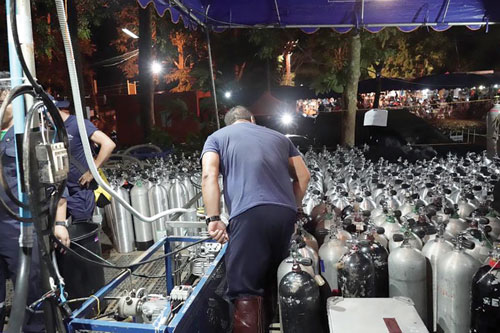
How would you describe the conditions to another diver?
For a cave diver, the procedural side of it wasn’t too bad, to be honest. Getting lost and line entanglement are the two big things you have to worry about. We didn’t really have those here; there was only one line in and out, so the cave protocols using line markers and cookies weren’t needed. This was also a big thick rope, not a thin cave line. In the restrictions, the tanks we were pulling between our legs would get entangled. It was impossible to avoid, but it was fairly easy to fix. It would have been a different situation if normal cave line had been used.
It also helped that most of the dive you simply pulled yourself along. You probably could have realistically done the water portions without fins as there was very little swimming involved. It was a case of hand-over-hand pulling your way, trying to avoid hitting as many things as possible as you squeezed through odd-shaped restrictions.
The deepest where we were was six metres [18 feet], and because it was quite narrow most of your body was scrapping along something. There weren’t too many sections where you were free swimming.
It’s going to be interesting to go back and see the topography of the cave.
We had lights, but they made minimal difference. Sometimes they would allow us to see if we were grabbing a line of not, but in reality you felt your way though the cave. With both hands required to navigate the cave, only helmet-mounted torches were used. Underwater they would barely provide you a reference point as you pulled along, but obviously crucial in the surface areas of the cave.
We were all in our standard sidemount kits, except two of the guys, who were on rebreathers. We had one sidemount, and one chest-mounted rebreather. Then we had Rick’s inner tube! [Rick Stanton dives with an inner tube in place of a BCD – Ed.]
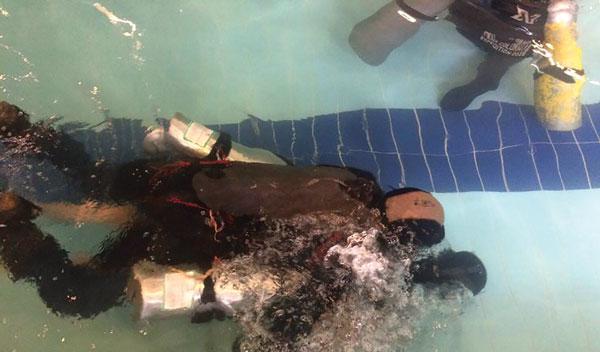
How did you feel at the end of the first dive?
I was a little bit relieved. You go in hearing these bad things, and we got a little bit lucky. The weather had calmed down and we didn’t get nearly the same flow as the other guys were dealing with. As soon as you know what you’re getting into your nerves get a lot more settled. I felt a lot more confident on day two or three, than I did on day one. Getting that first dive under your belt, you know where you are and the worst you’re going to see.
While this was going on, there was a gargantuan international effort outside the cave…
Yeah, there was 9000 people in total, when you include all the food and cleaning. It was massive. You’d think with all the hiking and climbing you’d loose weight but I think I gained a couple of kilos [5lbs]! You come out and there’s 14 plates of food, the guy taking care of us even knew what colour Gatorade I liked. There was no shortage of hospitality. McDonalds was dropping off 500 burgers at a time. KFC had a little stand there.
At some point the decision is made to go in…
Everything had to be on a volunteer basis, especially after we lost the Thai Navy SEAL. The US and Australian military weren’t allowed to go past sump three. Just because you’re Navy SEALs doesn’t mean you’re trained in cave diving, so their governments said this was outside of their skill set.
When it came down to doing it, they let us know the plan, and it was up to us if we wanted to choose to be a part of it.
They didn’t want to fly in a bunch more people because they wouldn’t know the cave at that point. So it was the logical choice for us to keep helping.
Did any part of you want to say no?
We were so emotionally invested in it already. You’d sit there and think about it, but it didn’t take us more than 15 seconds to say yeah, we’re all in. You can’t walk away from that.
Part 2 coming soon…
Leave a Comment







